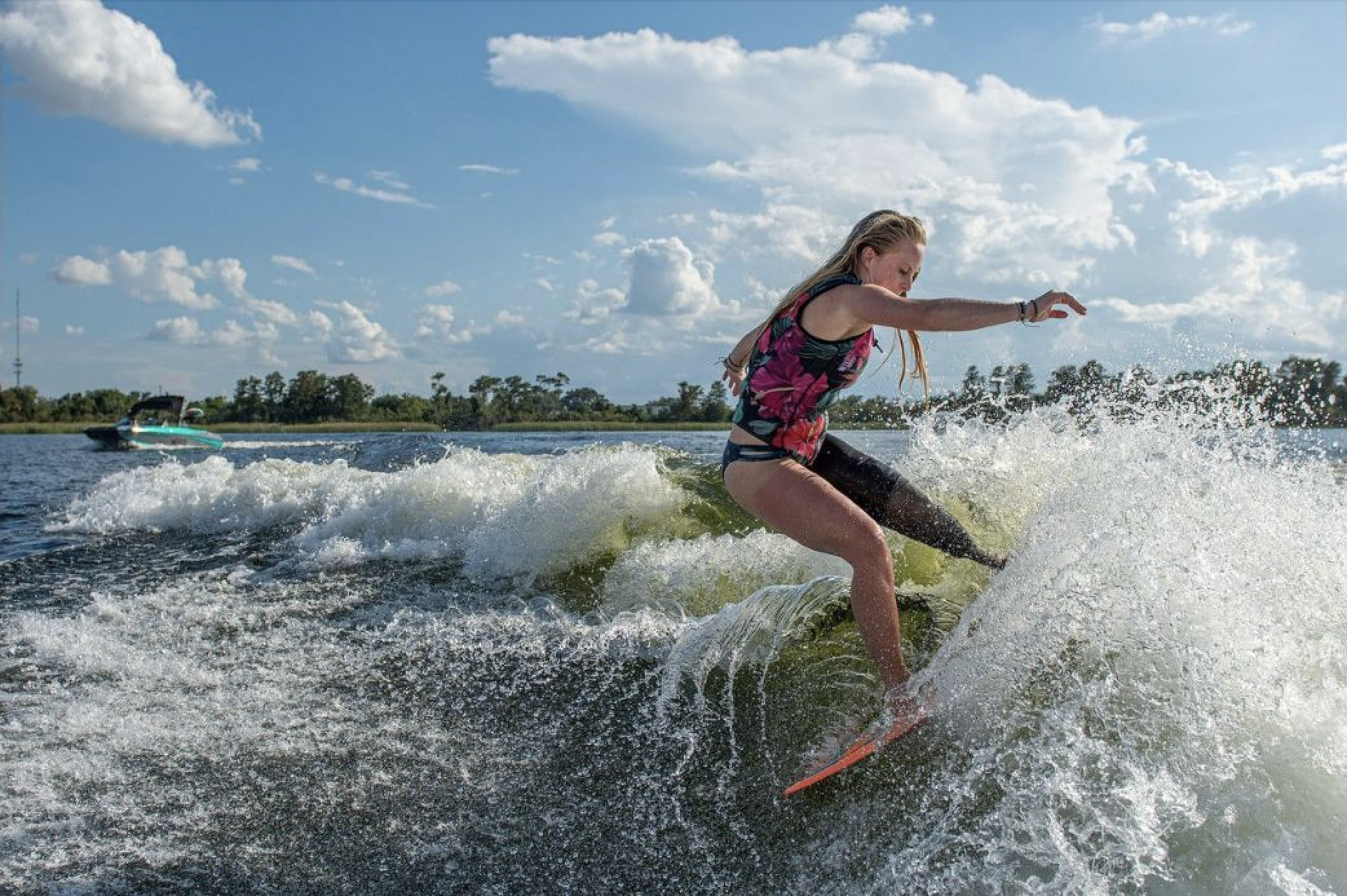
Lexi Kuppler, founder of Brave the Wave. Photo: Regatta Girl Photography
Growing up on a lake, Lexi Kuppler developed a passion for water sports at an early age. She spent her summers behind boats, sharpening her skills and forming a deep connection with the water. At age 16, Kuppler’s life was flipped upside down when she lost the lower half of her left leg in a boating accident. Luckily, she never lost her love for water sports.
As Lexi navigated the challenges of life as an amputee, she found the water to be incredibly healing. She wanted to share with the adaptive community what she had learned and teach the importance of pushing the limits of what we think is possible. And so, in 2019, Kuppler founded Brave the Wave to share the sport of wakesurfing with the adaptive community across the United States. Here Kuppler shares how she found the motivation to get back in the water after her accident, the mission of Brave the Wave, and her experiences working and surfing with adaptive athletes.
What is the mission of Brave the Wave?
Changing lives one wave at a time! The goal of Brave the Wave is to bring together the adaptive community through the sport of wakesurfing. When teaching individuals how to wakesurf, we have seen a transformation in their world realizing that, as humans, we are capable of doing so much more than we ever thought possible.
How did you find the motivation to get back in the water after your accident?
I never wanted to stop doing what I love, and the water is where I feel most at home. Getting back in the water was never a question for me. When it came time the following summer after my accident to get back to wakesurfing I jumped right in. Ten plus years ago when I started wakesurfing with a prosthetic post-accident the resources for prosthetic feet to wear doing action sports and water activities were very limited. Fast forward to today and technology has advanced to allow amputees to do amazing things with their prosthetics in all realms of action sports.
A prosthetic specialist company, BioDapt, has created action sports prosthetic gear we highly recommend for leg amputees aspiring to wakesurf while standing. With the amazing community I have surrounded myself with in the adaptive world it has inspired me to take on each new challenge I am faced with, which includes always growing my skills while wakesurfing.
Who are your programs geared towards?
Our focus as an organization is to reach those with all types of physical disabilities. We are not limited to just amputees, and we love finding ways to get adaptive wakesurfing to the entire community of those with physical disabilities. I, myself, am an amputee and have had the privilege to meet so many other adaptive individuals across the world. Wakesurfing, water sports, and just being on a boat in general is a fairly rare thing for your average human, let alone adaptive individuals.
Having had the opportunity to experience the pure bliss that comes from even just an afternoon on the boat, I wanted to share that with anyone and everyone I could. Access to boats (especially the amazing ones we get to ride behind), boards, watersport’s gear, and water-ready prosthetic equipment can be hard to come by. With the help of our partners, we seek to bring everything together for ‘just show up’ free events and give an experience to someone who might never have had that chance otherwise.
What types of adaptations do you make to accommodate participants?
Wakesurfing is a unique sport as it is a very low impact sport due to the speed of the boat being around 11 miles per hour. What makes this sport very accessible for the adaptive community is the variety of ways we have created to adapt riding techniques specifically for each rider. As a team we view coaching each participant differently as no rider learns the same way.
Some examples of ways we adapt riding are via foot straps (best results for an above knee or hip disartic to use a foot strap when wearing a prosthetic to surf), tandem riding (an instructor on the board with the rider), a seated cage (for those who are paralyzed, high leg amputation, bi-lateral leg amputation, etc.) or an arm and/or wrist strap (allows for a dual grip when missing an upper extremity or weakness in an upper extremity).
How do you teach adaptive wakesurfing?
We get creative and think outside the box at all times! We take the basics of wakesurfing and analyze each rider to reach their specific needs for riding, as well as driving the boat to reach their needs. When teaching any adaptive sport there is not one way to do things. It’s important to remember there is always a way to overcome the adversity of any physical disability to make learning something like wakesurfing possible. We are firm believers if you have the mindset to achieve it, we can accomplish anything!
What has your experience working with amputees at Brave the Wave been like?
Since the start of our program, we have seen people get inspired to eat healthier, branch out and try new things, compete in wakesurfing, and take control of other health issues. It’s truly a blessing to be able to help show people what they’re capable of.

